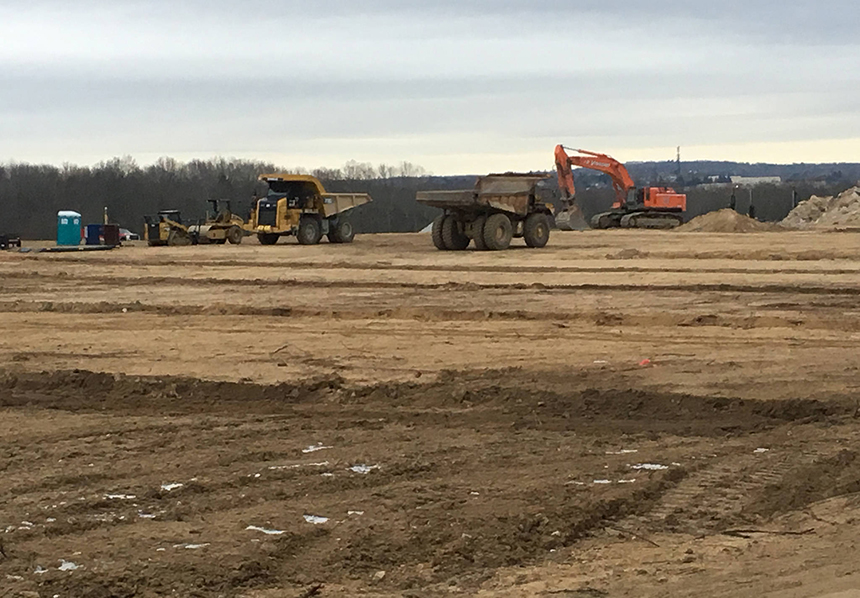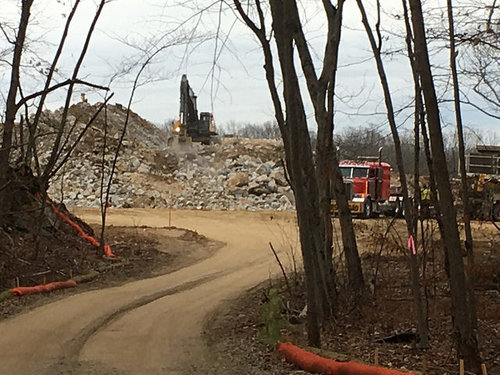We believe stripping land is a bad decision. There's too many other options available that do not carry a high environmental costs. Let's stop doing this.

Some of the 60 acres of forestland in western Cranston were clear-cut to make room for a 60,000-panel solar facility. (Douglas Doe)
Rhode Island is currently paying for the expansion of its renewable-energy portfolio with trees and farms. Does that really mean the state is going green?
By FRANK CARINI/ecoRI News staff
Scott Millar has shared the numbers over and over again. Rhode Island’s forests absorb, on average, 88 tons of carbon dioxide per acre. With about 400,000 acres of forest in the state, that’s 35 million tons of carbon sequestered annually for free — the emissions equivalent of 6 million cars.
The state’s forests, however, are being felled indiscriminately to build, for example, an office park in Johnston, a casino in Tiverton, a possible fossil-fuel power plant in Burrillville and, in an ironic twist, solar arrays in rural locations.
Rhode Island’s expanding renewable-energy sprawl has Millar, manger of community technical assistance for Grow Smart Rhode Island, some municipal planners, such as Exeter’s Ashley Sweet, and others concerned.
“Renewable energy is a great thing, but we’re cutting down trees and eating up farmland for green energy that ends up being not that green,” Sweet said. “We shouldn’t be relaxing restrictions. Renewable energy makes everyone feel good and that we should be supporting this. But developers want to blow open ordinances to do it.”
Renewable energy does need southern New England’s support, but people like Millar and Sweet and organizations such as Grow Smart and the Audubon Society of Rhode Island believe where these projects are sited needs to be a big part of the equation.
“We’re such a small state we need to use our land area more effectively,” Millar said. “Our rural-urban edge is vital and we need to protect that. We need to protect our natural resources. We need large blocks of forest, but we are slowly losing these spots.”

Cranston resident Douglas Doe has documented the destruction of forestland in his neighborhood, to make room for 60,000 solar panels. He said site preparation work, including the clear-cutting of some 60 acres, for the Gold Meadow Farms solar array off Lippitt Avenue, which abuts permanently protected open space, began last September. The work has left the site’s soil heavily compacted.
“A massive front loader grabbed the trees and a saw cut through it,” the Cranston Conservation Commission member said. “Then logging trucks spent the next two months coming and going.”
After the trees were cleared, Doe said site preparation turned into a gravel operation for about three months, complete with gravel crushers and conveyor belts. The blasts, seven in all, started in December. More trucks, this time filled with crushed stone, started entering and exiting.
“It was a big, old forest with boulders and ledge,” Doe said. “Once they removed the trees, they exposed a huge vein of rock and ledge, and then the blasting began. They blasted right up to the edge of the wetlands.”
Earlier this year, the Rhode Island Department of Environmental Management (DEM) cited the owner of the property, DSM Realty Corp., for significant noncompliance for allowing the unauthorized alteration of freshwater wetlands.
Other utility-scale solar projects are in the works in Cranston, such as some 50 acres of panels on a 75-acre agricultural tract on Hope Road.
Mayor Allan Fung told the Cranston Herald last year that he wants “Cranston to be the lead in the state in solar power.”
Doe said the city’s rush to be a solar leader has changed neighborhoods and ruined landscapes.
“The mayor can’t wait to get out there with his golden scissors,” Doe said....

No comments:
Post a Comment